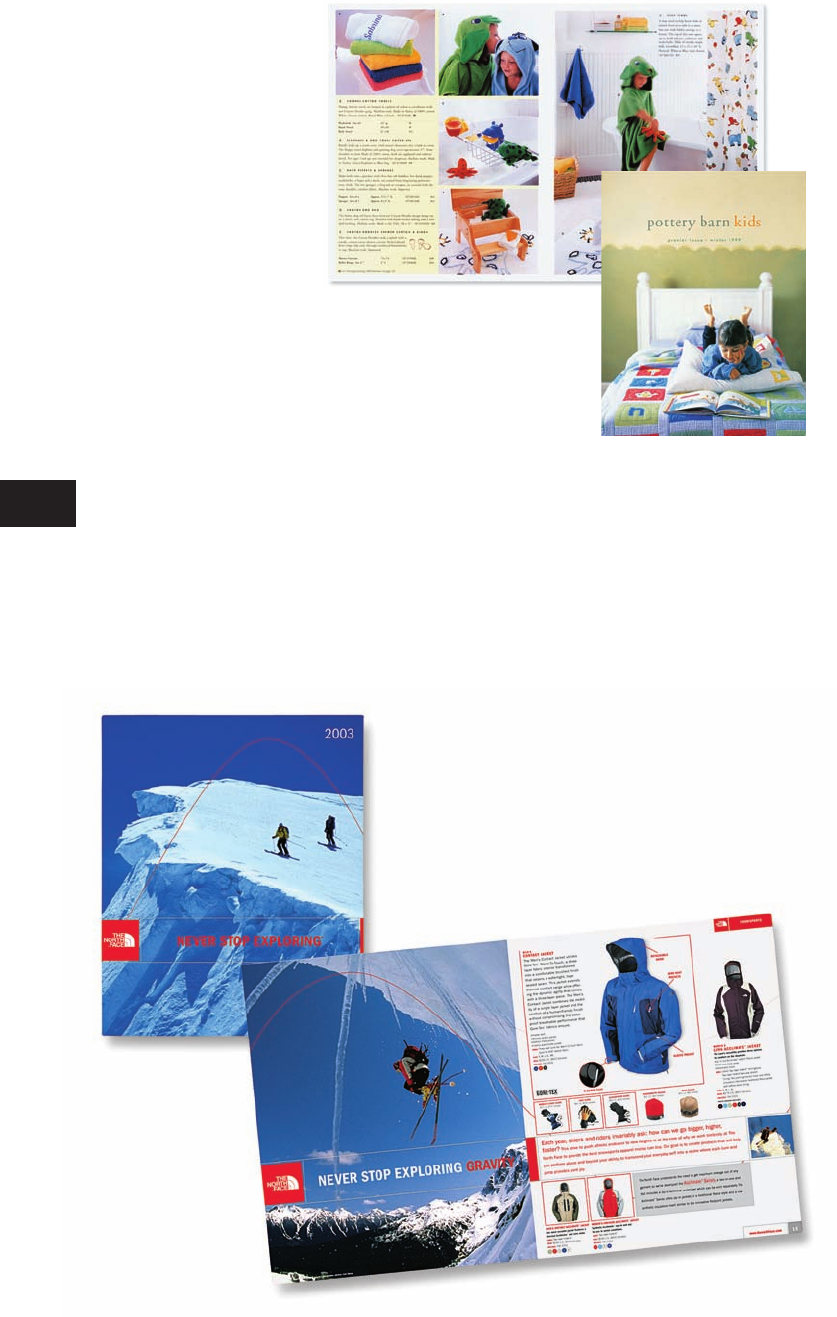
The Complete Graphic Designer
108
Brochures and catalogs have similar functions in that
their primary goal is to sell products or services to
a specifi c target market. The difference between
them is that brochures tend to feature only one line
of products or services, and are used as leave-behind
pieces by salespeople who will ultimately follow up
with a customer, whereas catalogs contain a variety of
items from different product lines, and are delivered to
the customer without a sales person to help persuade
them into action. The catalog must therefore work
harder to engage the viewer through beautiful photog-
raphy and detailed descriptions.
Catalogs often use imagery that
not only appeals to the audience
but shows the product in use. North
Face, a high-end outdoor apparel
company, provides customers with
a variety of information by featuring
dramatic action and close-up shots
that highlight product features and
fabrics along with color choices or
corresponding accessories.
Design: Satellite Design
Catalog Design
In this Pottery Barn Kids catalog,
children are shown using the actual
products. The use of professional
models within a catalog makes the
images seem more realistic and the
products more appealing.
Design: Cahan & Associates
TB
Provision-Complete Graphic Designer
CD109-59/4028
1st
proof
CGD p084-111_Text file_.indd 108CGD p084-111_Text file_.indd 108 1/20/09 10:37:42 AM1/20/09 10:37:42 AM

Common Design Jobs
109
Effective catalogs allow users to
quickly locate the information they
need. The simplest way to do this is
to organize the content into clearly
defi ned and labeled sections that
are easy to fi nd and differentiate.
These product categories may be
defi ned by the type of item, the
function it performs, or where it is
used. Graphically, the designer may
use large images, headlines, or col-
or coding to indicate the various
sections. It is equally imperative
that the layout fl ow from spread to
spread is easy to navigate, which a
well-defi ned grid can ensure.
Since buyers usually do not have
physical interaction with a product,
it is important that featured items are
represented accurately in the catalog
through clear photography and de-
tailed descriptions. Size, color, price,
and other distinguishing character-
istics should be highlighted in the
body copy for quick recognition.
The Old House Style Guide for Rejuvenation
chose a unique way to showcase its various
products. The turn-wheel format allows users to
select the decorating period they are interested
in and then provides useful background informa-
tion about that era. Once a style is selected
by turning the rotating wheel, appropriate
furnishings and fi xtures for that time period are
displayed through die-cut windows on the back.
Design: Gardner Design
TB
Provision-Complete Graphic Designer
CD109-59/4028
1st
proof
CGD p084-111_Text file_.indd 109CGD p084-111_Text file_.indd 109 1/20/09 10:37:45 AM1/20/09 10:37:45 AM

The clean and contemporary style of West Elm’s
furniture and accessories are clearly commu-
nicated through the geometric layouts of the
catalog. Cool colors and a discernable grid lend
a clean elegance to the design, while location
photography complements the actual products.
Design: Templin Brink
The Complete Graphic Designer
110
TB
Provision-Complete Graphic Designer
CD109-59/4028
1st
proof
CGD p084-111_Text file_.indd 110CGD p084-111_Text file_.indd 110 1/20/09 10:37:49 AM1/20/09 10:37:49 AM

Common Design Jobs
111
Some catalogs consist of a narrative about a company or its products,
or establish a tone for the piece through imagery. Psychedelic patterns
adorn the front of this bar stool and chair catalog, while gritty collaged
illustrations are interspersed throughout, running alongside the actual
product photography.
Design: Shira Shechter Studio
Catalog Design Considerations
1. Contact information
Contact information, including phone numbers and
website addresses, is essential to the layout and must
appear on every spread in case a customer tears a page
from the catalog and would like to place an order.
2. Detailed product photography
Every image should not only show the product in
its best light, but the tone of the photography must
match the tone of the catalog and convey qualities
that express the nature of the brand. Color is critical—
what the customer sees in the catalog should clearly
refl ect the actual item in every way.
3. Navigation
Catalogs should be easy to use. Label all product images
with numbers or letters that correspond with descrip-
tions that appear near the photo or in a specifi c location
on the page.
4. Ordering information
Sizing charts, billing information, shipping instruc-
tions, and payment details are essential for a success-
ful transaction. Make sure this area is well organized
and complete.
TB
Provision-Complete Graphic Designer
CD109-59/4028
1st
proof
CGD p084-111_Text file_.indd 111CGD p084-111_Text file_.indd 111 1/20/09 10:37:53 AM1/20/09 10:37:53 AM
Get The Complete Graphic Designer now with the O’Reilly learning platform.
O’Reilly members experience books, live events, courses curated by job role, and more from O’Reilly and nearly 200 top publishers.

